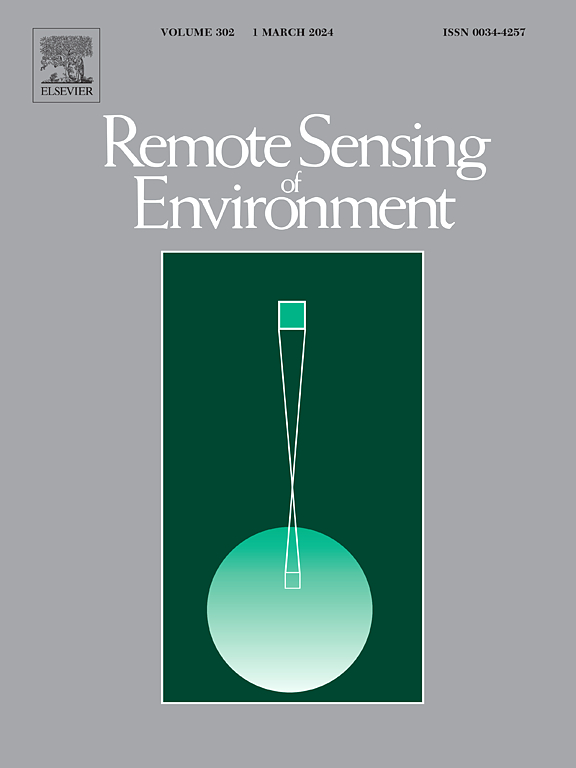High spatial-resolution satellite mapping of suspended particulate matter in global coastal waters using particle composition-adaptive algorithms
IF 11.4
1区 地球科学
Q1 ENVIRONMENTAL SCIENCES
引用次数: 0
Abstract
Delivery of suspended particles, referred hereafter also to as suspended sediment, to coastal zones plays a first order control on the development and maintenance of muddy geomorphic features like river deltas, mudflats, and tidal wetlands. While sediment delivery from rivers is relatively straightforward to monitor and has been well studied, suspended sediment derived from erosion of coastal bluffs and resuspension of shallow subtidal sediments remains poorly constrained. Estimates of the concentration of suspended particulate matter (SPM) provide one of the best remotely sensed metrics for suspended sediment supply to the coast. Spaceborne ocean color sensors with coarse spatial resolution (∼1 km pixel size at nadir) are generally inadequate to resolve smaller-scale sediment dynamics in coastal waters and additionally there is a limitation associated with adjacency effect of 1-km land pixels on near-shore water pixels. In contrast, satellites dedicated primarily to land observations with a smaller pixel size (∼30 m) provide more adequate spatial resolution for observations of coastal waters. This paper presents a particle composition adaptive algorithm for retrieving SPM from ocean remote-sensing reflectance, Rrs(λ), in coastal waters which is applicable to most land observation satellites. For the algorithm development, we compiled more than 800 paired in situ spectral reflectance and SPM measurements from 12 marine sites worldwide, representing a wide range of suspended particle concentration and composition. We first classify the satellite image data into three water types: organic-rich, mineral-rich, or extremely mineral-rich based on the POC/SPM ratio that is derived from Rrs(λ). The ratio of particulate organic carbon (POC) to SPM serves as a particle composition metric. Then, SPM is estimated from Rrs(λ) using a particle composition-specific algorithm which employs the reflectance at red band for organic-rich waters and near-infrared (NIR) for mineral-rich waters. We compared the performance of this algorithm with eight previously published SPM algorithms, including empirical, semi-analytical, and machine learning approaches. Results show that our algorithm produces reliable SPM estimation with coefficient of determination (R2), root mean square error (RMSE in log space), and median absolute percent error (MAPE) of 0.91, 0.20, and 30.5 %, respectively. To examine the capability of our algorithm to study the long-term variability in coastal SPM at high spatial resolution, we implemented the algorithm to the 40-year Landsat data archive in Google Earth Engine (GEE). The Landsat mapping results of SPM were validated using both the satellite-in situ matchups of SPM data as well as in situ water turbidity measurements. Finally, we demonstrate a few scenarios of fine-scale SPM patterns as well as seasonal and long-term variability across different marine coastal environments using the satellite high spatial resolution SPM mapping. These results collectively demonstrate the promise of this new SPM retrieval algorithm for mapping and monitoring global coastal suspended sediment dynamics.
使用粒子成分自适应算法的全球沿海水域悬浮颗粒物的高空间分辨率卫星制图
悬浮颗粒(以下简称悬浮泥沙)向海岸带的输送对河流三角洲、泥滩和潮汐湿地等泥质地貌的发育和维持起着一级控制作用。虽然来自河流的沉积物输送相对容易监测,并且已经得到了很好的研究,但由于海岸悬崖侵蚀和浅层潮下沉积物的再悬浮而产生的悬浮沉积物仍然很少受到限制。悬浮颗粒物质(SPM)浓度的估计提供了向海岸供应悬浮沉积物的最佳遥感指标之一。星载海洋颜色传感器具有粗糙的空间分辨率(最低点约1公里像素大小),通常不足以解决沿海水域较小尺度的沉积物动力学问题,此外,1公里陆地像素对近岸水域像素的邻接效应也存在局限性。相比之下,主要用于陆地观测的卫星具有较小的像素尺寸(~ 30 m),为沿海水域的观测提供了更充足的空间分辨率。本文提出了一种适用于大多数陆地观测卫星的沿海海域海洋遥感反射率Rrs(λ)反演SPM的粒子组成自适应算法。为了开发算法,我们收集了来自全球12个海洋站点的800多个配对的原位光谱反射率和SPM测量数据,代表了广泛的悬浮颗粒浓度和组成。我们首先根据Rrs(λ)得出的POC/SPM比率将卫星图像数据分为三种水类型:富有机物、富矿物质或极富矿物质。颗粒有机碳(POC)与SPM的比值可作为颗粒组成度量。然后,利用粒子组成特异性算法从Rrs(λ)中估计SPM,该算法利用富有机水的红光波段反射率和富矿物质水的近红外波段反射率。我们将该算法的性能与之前发表的八种SPM算法进行了比较,包括经验、半分析和机器学习方法。结果表明,我们的算法产生了可靠的SPM估计,其决定系数(R2)、对数空间的均方根误差(RMSE)和中位数绝对百分比误差(MAPE)分别为0.91、0.20和30.5%。为了验证该算法在高空间分辨率下研究沿海SPM长期变化的能力,我们将该算法应用于谷歌Earth Engine (GEE)的40年Landsat数据存档。利用SPM数据的卫星原位匹配以及原位水浊度测量,对SPM的Landsat制图结果进行了验证。最后,我们利用卫星高空间分辨率SPM制图展示了几种不同海洋沿海环境的精细尺度SPM模式以及季节和长期变化。这些结果共同证明了这种新的SPM检索算法在绘制和监测全球沿海悬浮泥沙动力学方面的前景。
本文章由计算机程序翻译,如有差异,请以英文原文为准。
求助全文
约1分钟内获得全文
求助全文
来源期刊

Remote Sensing of Environment
环境科学-成像科学与照相技术
CiteScore
25.10
自引率
8.90%
发文量
455
审稿时长
53 days
期刊介绍:
Remote Sensing of Environment (RSE) serves the Earth observation community by disseminating results on the theory, science, applications, and technology that contribute to advancing the field of remote sensing. With a thoroughly interdisciplinary approach, RSE encompasses terrestrial, oceanic, and atmospheric sensing.
The journal emphasizes biophysical and quantitative approaches to remote sensing at local to global scales, covering a diverse range of applications and techniques.
RSE serves as a vital platform for the exchange of knowledge and advancements in the dynamic field of remote sensing.
 求助内容:
求助内容: 应助结果提醒方式:
应助结果提醒方式:


